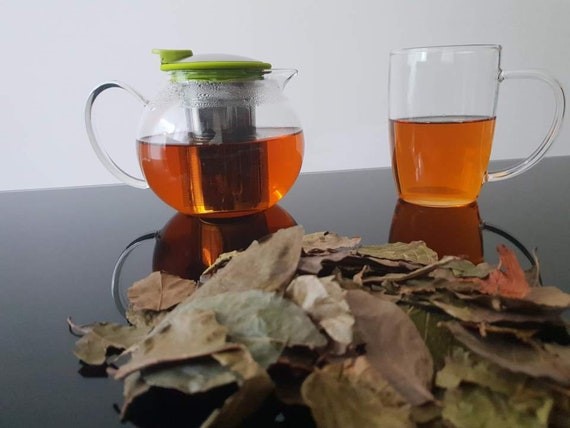What is Kinkeliba?
Kinkeliba has the botanical name Combretum micranthum. As a shrub, kinkeliba is more prevalent in the Gambia, Senegal, Benin, Burkina Faso and Mali. It is used for making tea, has uses in traditional medicine, and is used by many West African Muslims during Ramadan to break their fast. The name kinkeliba is believed to come from the Fulani language. It is referred to as sekhew in the Wolof language and ŋɔlɔbɛ in the Bambara language.
Kinkeliba Tea
Hearsay evidence attests to the fact that kinkeliba is normally used to treat liver ailments, improve stress, headache, weight, insomnia and much more, especially in Senegal and Mali. Wikipedia (2022) also confirmed that the name kinkeliba means ‘health tree’, and the French import kinkeliba and call it ‘tisane de longue vie’ or infusion of long life.
Wikipedia (2022) further narrates that Kinkiliba is used daily to brew a strong tea that is mixed with sugar and milk, and is drunk with bread at sundown as a means of breaking the daily fast. Kinkiliba is used specifically for this purpose because of its sweet flavour and because it is believed to be an appetite stimulant as those who have been fasting want to be able to enjoy as much rich food as possible in the evening after eating nothing from sunrise to sunset. In Burkina Faso, a decoction of the leaves is used as a medication for malaria.
Plant ingredients
Two studies (Schmelzer, G.H., 2012; Bougma et al. 2021) found several ingredients insolated or found in Kinkeliba, including orientin (luteolin-8-C-glucoside), homoorientin (luteolin-6-C-glucoside), myricetin-3-O-glucoside, and myricetin-3-O-rutinoside as well as the C-glycosylflavones vitexine and isovitexin and several flavane derivatives. The leaves contain a high number of total phenols (13–14 percent), including gallic acid, rutin trihydrate, catechin, epicatechin, epigallocatechin, and benzoic acid. From the leaves, a mixture of stereoisomers of the alkaloid betonicine has been isolated, called combetine (0.1 percent).
Others, such as stachydrine and hydrostachydrine, were confirmed. Another series of alkaloids were isolated from the leaves, called kinkeloids A–D, having a rare flavan-piperidine skeleton.
Fatty acids, such as Palmitic acid (37.8percent) and oleic and linolenic acids – together about 18 percent, potassium nitrate, tannins, the triterpenoids lupeol and α-amyrin, sugars, sorbitol and inositol, the amine choline and the sterol β-sitosterol, were isolated.
Kinkeliba – science
High blood pressure
One recent randomised clinical trial by Bourqui et al. (2021) compared kinkeliba and wonjo to examine their clinical effectiveness in the galenic forms of tablet and brew (decoction) in non-complicated hypertensive patients. The study involves 219 hypertensive patients with systolic blood pressure (SBP) between 140 and 180 mmHg and/or diastolic blood pressure (DBP) between 90 and 110 mmHg without cardiovascular or renal complications, who were involved in a multicentric randomised clinical trial in Senegal comparing five treatment regimens: bissap tablets (2 × 375 mg/day), bissap brew (10 g of calyx/day), kinkeliba tablets (2 × 200 mg/day), kinkeliba brew (10 g of leaves/day), and captopril (2 × 50 mg/day) as control. During the 6 months follow-up, a significant and equivalent decrease in systolic blood pressure was observed with the herbal drug approach and control group.
For kinkeliba and wonjo, regarding the galenic forms, the study further found that the brews appeared to be somewhat more effective than tablets. The study also notes that the rates of clinically significant effectiveness or decrease were 75 percent, 67 percent, and 65 percent with bissap, kinkeliba, and captopril, respectively.
After 6 months, a target blood pressure of <140/90 mmHg was attained by 49 percent of patients with bissap, 51 percent with kinkeliba, and 40 percent with captopril. Bissap and kinkeliba appeared, at doses utilised, to be as effective as captopril over the 6-month follow-up. This study also supports studies, especially with wonjo, which beat the pharmaceutical drug captopril in terms of blood pressure management (Nurfaradilla et al. 2020).
Others did not show any significant differences to the hypotensive effect (Herrera-Arellano et al. 2004). This means that you can use the herbal kinkeliba or wonjo alone in managing your blood pressure. The interesting thing about this study is that combining kinkeliba and wonjo could also serve as an effective herbal remedy for managing blood pressure.
A previous randomised controlled trial (Seck et al. 2017) with kinkeliba and Hibiscus sabdariffa in the galenic form of capsules of plant powder were compared against pharmaceutical drug for blood pressure management. In this study, one hundred and twenty-five patients were randomly allocated into group 1 (kinkeliba leaves 190 mg × 2/day), group 2 (bissap calyx 320 mg × 2/day), or group 3 (ramipril 5 mg /day) during four consecutive weeks.
A significant natriuretic effect was observed in the kinkeliba and bissap groups but not in patients under ramipril treatment. At the end of the four weeks, 39 percent of patients in the ramipril group, 37 percent of patients in the kinkeliba group, and 21 percent of those taking bissap had normalised their BP.
A more recent animal study (Kpemissi et al. 2022) administered for six weeks also demonstrated that kinkeliba has a positive effect on high blood pressure.
Another study by Traore et al. (2022) also found that kinkeliba is used in the management of arterial hypertension in Guinea. Mashi et al. (2022) in vitro study also found that kinkeliba could act as a standard drug for lowering blood pressure. A previous study in Mali also justifies the traditional use of kinkeliba in the management of hypertension (Coulibaly, Hawa, 2019).
Antimicrobial potential
The leaves of Combretum micranthum and C. racemosum are used as a herbal remedy to treat diarrhoea and various skin diseases. One study by Kola and Benjamin (2002) found kinkeliba to possess a greater antimicrobial ability.
Warnings – kinkeliba
Kinkeliba tea is generally safe. However, studies have demonstrated its ability to help lower blood pressure alone. Hence, those taking standard pharmaceutical drugs and also taking this tea should check their blood pressure as it could lead to hypotension. Consult your physicians in case you notice any side effects using this tea.
Take home
One of the most important health conditions studies have been conducted on is hypertension. Though more human studies are needed, two important randomised controlled clinical trials (Seck et al. 2017; Bourqui et al. 2020) were conducted in health centres around Saint-Louis du Sénégal. The research team was made up of medical doctors and pharmacists, professors and doctoral students from the University of Saint-Louis as well as trainees and Swiss volunteers from the Antenna Foundation.
Kingkeliba and Hibiscus were compared with pharmaceutical drugs for the treatment of mild to moderate hypertension, with a 6-month follow-up. The plants were prepared in the form of compressed powder (tablets) or tea (decoction). Five groups were compared – 2 groups of each plant, and reference treatment as a control group. It was found that the use of either plants, in either form, was associated with a reduction in blood pressure similar to that achieved with the reference treatment. The good news is that these studies were published in the renowned Journal of Human Hypertension. Avoid adding sugar.
NB: Prof. Nyarkotey has strict sourcing guidelines and relies on peer-reviewed studies, academic research institutions, and medical associations to justify his write-ups. My articles are for educational purposes and do not serve as medical advice for treatment. I aim to educate the public about evidence-based scientific naturopathic therapies.
>>>The writer is a Professor of Naturopathic Healthcare, a Medical Journalist, and a science writer. President, Nyarkotey University College of Holistic Medicine & Technology (NUCHMT)/African Naturopathic Foundation, Ashaiman, Ghana. He is currently a BL candidate at the Gambia Law School, Banjul, Gambia.
- mail: [email protected]
References
- Mabozou Kpemissi, Veeresh Prabhakar Veerapur, Doddamavattur Shivalingaiah Suhas, Tumbadi Adinarayanashetty Puneeth, Rudrappa Nandeesh, Sachidananda Vijayakumar, Kwashie Eklu-Gadegbeku(2022) Combretum micranthum G. Don protects hypertension induced by L-NAME by cardiovascular and renal remodelling through reversing inflammation and oxidative stress. Journal of functional foods 94 pp. 105132
- Schmelzer, G.H., 2012. Combretum micranthum G.Don. In: Schmelzer, G.H. & Gurib-Fakim, A. (Editors). Prota 11(2): Medicinal plants/Plantes médicinales 2. PROTA, Wageningen, Netherlands. Accessed 14 January 2023.
- CaraWelch , JingZhen , Emmanuel Bassène , Ilya Raskin , James Edward Simon, Qingli Wu(2018) Bioactive polyphenols in kinkéliba tea (Combretum micranthum) and their glucose-lowering activities. Journal of Food and Drug Analysis, Pages 487-496.
- Welch, Cara Renae. Chemistry and pharmacology of Kinkéliba (Combretum micranthum), a west African medicinal plant. Retrieved from https://doi.org/doi:10.7282/T3TM7B7P
- Bourqui, A., Niang, E.A.B., Graz, B. et al.Hypertension treatment with Combretum micranthum or Hibiscus sabdariffa, as decoction or tablet: a randomized clinical trial. J Hum Hypertens 35, 800–808 (2021). https://doi.org/10.1038/s41371-020-00415-1
- Herrera-Arellano A, Flores-Romero S, Chávez-Soto MA, Tortoriello J. Effectiveness and tolerability of a standardized extract from Hibiscus sabdariffa in patients with mild to moderate hypertension: a controlled and randomized clinical trial. Phytomedicine. 2004 Jul;11(5):375-82. doi: 10.1016/j.phymed.2004.04.001. PMID: 15330492.
- Kpemissi M, Eklu-Gadegbeku K, Veerapur VP, Potârniche AV, Adi K, Vijayakumar S, Banakar SM, Thimmaiah NV, Metowogo K, Aklikokou K. Antioxidant and nephroprotection activities of Combretum micranthum: A phytochemical, in-vitro and ex-vivo studies. Heliyon. 2019 Mar 28;5(3):e01365. doi: 10.1016/j.heliyon.2019.e01365. PMID: 30976670; PMCID: PMC6441829.
- Adjima Bougma, Aminata Sere, Bazoin Sylvain Raoul Bazie, Hassane Sangare, Judicaël Thomas Ouilly, Imael Henri Nestor Bassole(2021) Composition and physicochemical properties of Combretum collinum, Combretum micranthum, Combretum nigricans, and Combretum niorense seeds and seed oils from Burkina Faso. Journal of American Oil Chemists Society. https://doi.org/10.1002/aocs.12540
- Ajibesin Kola and A. Ekpo Benjamin(2002)Comparative Antimicrobial Activities Of The Leaves Of Combretum Micranthum And C. Racemosum. Global Journal of Medical Sciences. 10.4314/gjms.v1i1.10103
- Seck SM, Doupa D, Dia DG, Diop EA, Ardiet DL, Nogueira RC, Graz B, Diouf B. Clinical efficacy of African traditional medicines in hypertension: A randomized controlled trial with Combretum micranthum and Hibiscus sabdariffa. J Hum Hypertens. 2017 Dec;32(1):75-81. doi: 10.1038/s41371-017-0001-6. Epub 2017 Oct 10. PMID: 29311704.
- Mohamed S. Traore1, Aïssata Camara1, Mamadou A. Balde1, Mamadou ST. Diallo, Nene S. Barry, Elhadj S. Balde, Aliou M. Balde1(2022) Ethnobotanical survey of medicinal plants used to manage hypertension in the Republic of Guinea. J. Pharm. Pharmacogn. Res., vol. 10, no. 5, pp. 938-951.
- Rukaiyat Lawal Mashi, Michael Sunday Abu, Ojochenemi Ejeh Yakubu, Tatah Verwiyeh Silas and Mida Habila Mayel, 2022. Antioxidant and Angiotensin-Converting Enzyme Inhibitory Activities of Fractionated Extract of Combretum micranthum Journal of Biological Sciences, 22: 57-64.
- Coulibaly, Hawa(2019) Phytochemical study and biological activities of Combretum glutinosum Perr Ex. Dc, Combretum micranthum G.Don and Guiera senegalensis J. F Gmel (Combretaceae), used in the management of arterial hypertension in Mali. https://www.bibliosante.ml/handle/123456789/3692.










